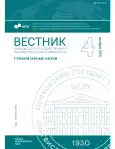Syntax of ‘Digital native Media’ vs. ‘Legacy Media’
- Authors: Vanko T.R.1
-
Affiliations:
- Moscow State Linguistic University
- Issue: No 4(885) (2024)
- Pages: 37-44
- Section: Linguistics
- URL: https://journal-vniispk.ru/2542-2197/article/view/303788
- ID: 303788
Cite item
Full Text
Abstract
In today’s digital space, two types of media coexist: online versions of traditional print media and digital native media. Both similarities and differences in their content, commercial potential, target audience, and development strategies are considered. Of particular interest is the study of their linguistic, particularly syntactic parameters to establish the similarities and differences of the means used to implement the main task of informing and manipulating public opinion.
About the authors
Tatiana Rostislavovna Vanko
Moscow State Linguistic University
Author for correspondence.
Email: bestgrammar@yandex.ru
PhD (Philology), Associate Professor, Department of Grammar and History of English, Faculty of the English Language
Russian FederationReferences
- Ye H. (2017). New questions emerge amidst rapid changes: Terry Flew, New Media. 4th ed. Global Media and China, 2(3-4), 353–356.
- Steensen, S. et al (2017). Theories of journalism in a digital age. Routledge, doi: 10.4324/9781315544205.
- Mitchelstein, E.; Boczkowski, P. (2009). Between tradition and change: a review of recent research on online news production. Journalism, 10(5), 562–586.
- Salaverria, R. (2019). Digital journalism: 25 years of research. Review article. El profesional de la formación, 28(1). 10.3145/epi.2019.ene.01.
- Riordan, K. (2014) Accuracy, Independence, and Impartiality: How legacy media and digital natives approach standards in the digital age. University of Oxford.
- Vara-Miguel, A. (2020). Cross-National Similarities and Differences between Legacy and Digital-Born News Media Audiences. Media and Communication, 8(2), 16–27.
- Diel, S. (2017). New Media, Legacy Media and Misperceptions Regarding Sourcing. KOME: An International Journal of Pure Communication Inquiry, 5(1), 104–120.
- Manovich, L. (2002). The Language of New Media. Cambridge: The MIT Press.
- Nichols, T., Shabbir, N., Nielsen, R. K. (2016). Digital-born news media in Europe. Oxford: Reuters Institute for the Study of Journalism.
- Vázquez-Herrero, Negreira-Rey, López-García. (2023). “Research on digital native media: an emerging topic in the field of digital communication”. Profesional de la información, V. 32, № 2.
- Goroshko, E. I. (2013). Vozniknovenie lingvistiki novykh media i perspektivy razvitiya ehtogo napravleniya =The Emergence of New Media Linguistics and the Prospects for the Development of this Field. Hypertext as an Object of Linguistic Research (pp. 27–41): Proceedings of the III International Scientific and Practical Conference. Samara: PGSGA. (In Russ.)
- Dobrosklonskaya, T. G. (2020). Media Linguistics: Theory, Methods, Directions. Moscow: KDU, Dobrosvet. (In Russ.)
- Dubina, L. V. (2013). Trends of development of the Russian language in the context of Internet-communication. Vestnik of Tomsk State Pedagogical University (TSPU Bulletin), 2(130), 177–181. (In Russ.)
- Glazko, P. P. (2022). Functional and pragmatic characteristics of syntactic devices in the genres of American and Belarusian media space. Vestnik of Moscow State University. Journalism, 10(1), 136–151. (In Russ.)
- Van’ko, T. R. (2022). ‘Digital native media’ syntax. Vestnik of Moscow State Linguistic University. Humanities. 3(858), 16–23. (In Russ.)
- Negredo, S.; Sanchez-Garcia, P.; Amoendo-Casais, A.; Martinez-Costa, M. P., Salaverria, R. (2023). quantifying digital-native and legacy, national and local news websites in Spain, their topic scope and platforms. Anàlisi: quaderns de Comunicació i Cultura, 68, 81–96.
Supplementary files










